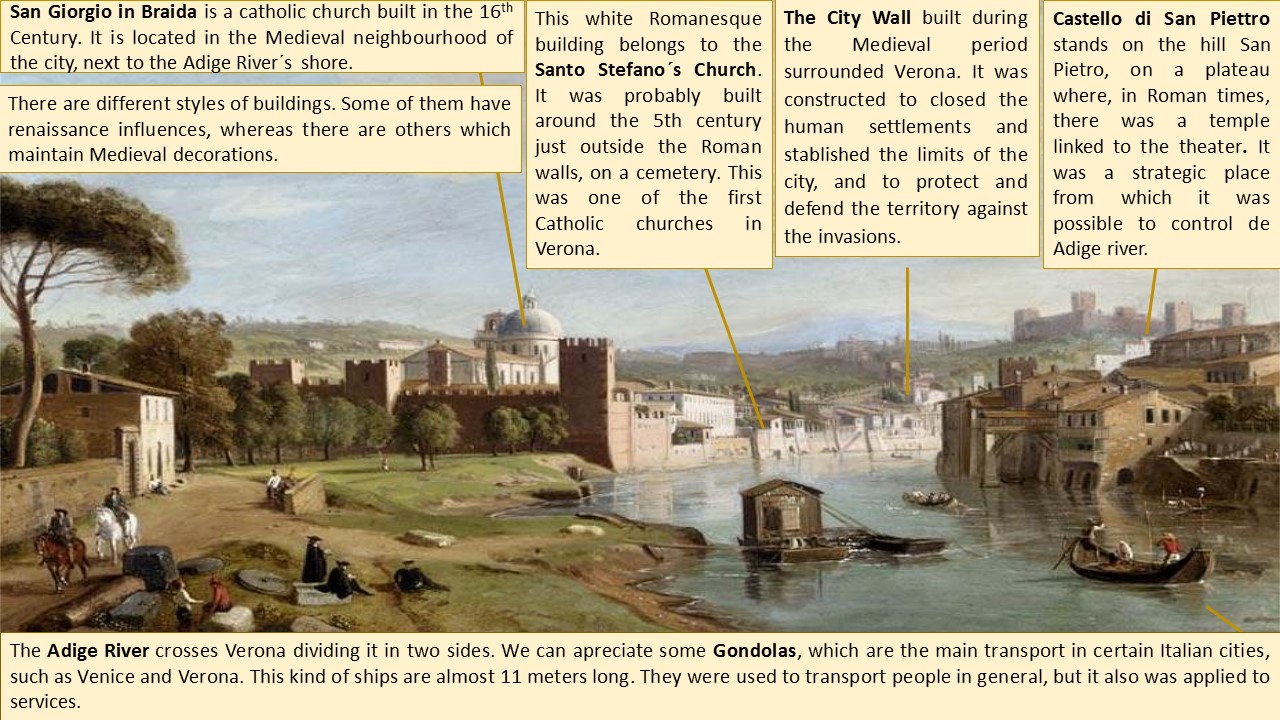VERONA (Caspar A. Van Wittel, 18th Century)
This work of art belongs to the city of Verona. Its author was the Dutch painter, Caspar Van Wittel, commonly known as Vanvitelli (1653-1736). Van Wittel moved abroad form the Nederland’s to Rome with his family and spent all his life there. This is the reason why most of his artworks represent Italian sites, like the one we are going to work on. The picture entitled A View of the River Adige at San Giorgio in Braida, was made during the first decade of the 18th Century, and as we can appreciate, it represents the Adige River next to the church of San Giorgio in Braida. Nowadays, the picture owns to a private collection.
The image portrays some details, with pastel colours, about a typical day in the city of Verona in the 18th Century. The first thing we can appreciate is the Adige River and its two shores. Both riversides are plenty of diverse types of buildings from dissimilar periods which show the variety of art styles that have influenced Verona. According to the proximity between the buildings and also, the way they are surrounding the river, we can say that the city follows a nucleated pattern. We can not see very well the urban layout, but having into account some details, like the presence of some monuments such us the Medieval City Wall, we can guess that it was an irregular morphology. The structure of the city is divided in three parts: the left one is very compact and the buildings are clustered; the opposite side is older so the types of buildings are more degraded; finally, in the background there is a strategic place, which is in the hill of the mountain to control the river.
Broadly, we can distinguish between Medieval monuments, as the City Wall, Romanesque style in San Piettro´s Castle and some Renaissance impacts like San Giorgio in Braida´s Cathedral. Probably, the part that we are going to analyse belongs to the primitive settlement of Verona, but, as every city, it has been growing distinguishing between the left side, which belongs to the newest part of the city, whereas the opposite one owns to the oldest in those years. However, when we look at the picture, the Adige River catch our attention. It is important to stand out that point, because it entails a fundamental aspect of the location of Verona. Since the Ancient Ages, human settlements were stablished close to the rivers to provides people water and food. That’s the reason why the houses are along the riverside.
This painting also allows us to talk about the characteristics of the environment. We can see some people in the foreground, very useful to know about the typical clothes and the social activities of the 18th Century. Finally, we can talk about the means of transportation. The common one was the horses and the carriages, but it is important to highlight the gondolas, which are the main transport in certain Italian cities. This kind of ships were used to transport people in general, but it also was applied to services such as the trade. This is connected to the economic sectors: the first sector is present in activities such as fishing in the river or agriculture probably done in the fields of the background, the second sector is linked to the construction of the buildings and the third one concerns trade and transport. Another curious fact to note is the proximity between the City Wall and the buildings, which indicates that the city has been growing. Its function was to ensure protection and security to the citizens. The location of San Piettro´s Castle, also, fulfilled a very relevant task related to this issue. The high of the hill where it is situated, allowed the inhabitants to control the Adige river and avoid possible attacks.
Lucía Plaza Suárez

